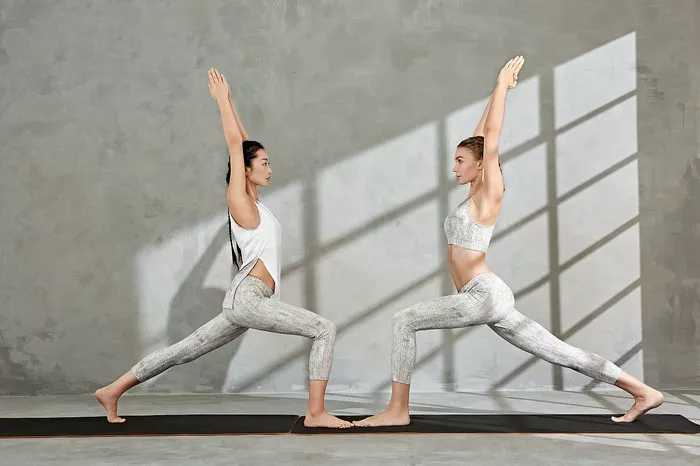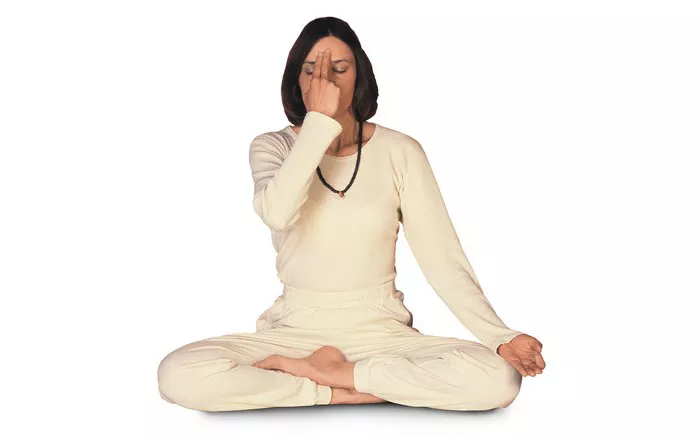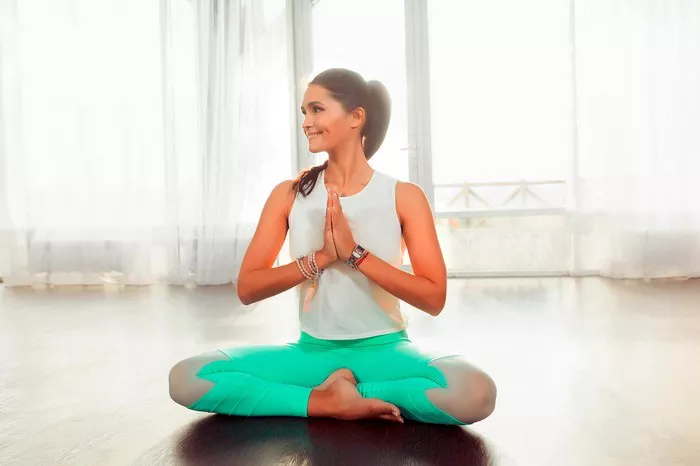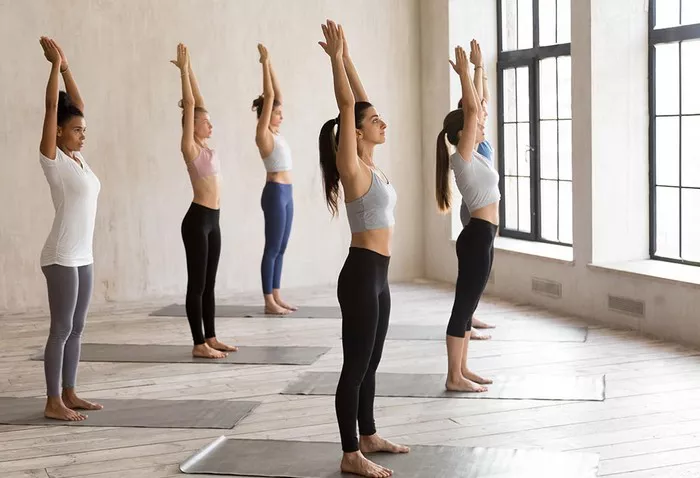Partner yoga, a fusion of gymnastics and yoga, offers a unique opportunity for individuals to deepen their practice while building trust and connection with a partner. This article explores eight dynamic gymnastics yoga poses designed for two people, providing step-by-step instructions and tips for safe and effective practice.
1. Double Downward Dog
Description: Double downward dog is a variation of the traditional downward dog pose, performed with two partners facing each other.
Instructions:
- Begin in a kneeling position facing your partner, with your hands shoulder-width apart on the ground in front of you.
- Lift your hips up and back, straightening your arms and legs to come into a downward dog position.
- Your partner should mirror your position, with their hands shoulder-width apart and hips lifted towards the ceiling.
- Walk your feet forward until your hips are aligned over your shoulders, creating a stable base.
- Gently press into each other’s feet for added stability and support.
- Hold the pose for several breaths, focusing on lengthening through the spine and relaxing the shoulders.
- To release, slowly walk your feet back towards your partner and come back to a kneeling position.
Tips:
- Communicate with your partner to ensure both of you feel comfortable and supported in the pose.
- Keep your gaze soft and steady to maintain balance and stability.
- Engage your core muscles to support your lower back and pelvis.
2. Partner Boat Pose
Description: Partner boat pose is a challenging balancing pose that requires coordination and core strength from both partners.
Instructions:
- Sit facing your partner with your knees bent and feet flat on the ground.
- Hold hands with your partner and lean back slightly, engaging your core muscles.
- Lift your feet off the ground, bringing your shins parallel to the floor.
- Gradually straighten your legs and extend your arms forward, finding your balance in a floating boat position.
- Keep your spine long and your chest lifted, avoiding rounding through the back.
- Hold the pose for several breaths, maintaining steady breathing and focus.
- To release, gently lower your feet back to the ground and come back to a seated position.
Tips:
Use your partner’s hands for support and stability throughout the pose.
Keep your gaze focused on a point between you and your partner to help maintain balance.
Engage your core muscles and press firmly into the ground with your sitting bones to lift into the pose.
3. Acro Yogi Throne
Description: Acro Yogi throne is an acrobatic pose that combines elements of yoga and gymnastics to create a strong foundation and sense of stability between partners.
Instructions:
- One partner sits on the ground with their knees bent and feet flat on the floor, leaning back slightly to support their weight on their hands.
- The other partner stands facing the seated partner, placing their hands on the seated partner’s knees.
- The standing partner leans forward, shifting their weight onto their hands and extending their legs back into a plank position.
- The seated partner can adjust their hand position to provide support and balance for the standing partner.
- Hold the pose for several breaths, maintaining stability and alignment.
- To release, the standing partner gently lowers their legs back to the ground, and both partners come back to a seated position.
Tips:
- Communicate with your partner to find a comfortable and stable position for both of you.
- Engage your core muscles and press firmly into the ground with your hands to support your weight.
- Keep your gaze focused on a point between you and your partner to help maintain balance and stability.
4. Double Tree Pose
Description: Double tree pose is a balancing pose that requires concentration, coordination, and communication between partners.
Instructions:
- Stand side by side with your partner, facing in the same direction.
- Shift your weight onto one foot and lift the opposite foot, placing the sole of your foot against the inner thigh of your standing leg.
- Bring your hands together in front of your chest in a prayer position, or reach your arms overhead and clasp hands with your partner.
- Find your balance and stability in the pose, focusing on a point in front of you for concentration.
- Hold the pose for several breaths, maintaining steady breathing and focus.
- To release, gently lower your lifted foot back to the ground and come back to a standing position.
Tips:
- Use your partner’s hand or shoulder for support if needed to maintain balance.
- Engage your core muscles and press firmly into the ground with your standing foot to stabilize your posture.
- Communicate with your partner to find a comfortable and balanced position for both of you.
5. Flying Lunge
Description: Flying lunge is an advanced yoga pose that requires strength, balance, and coordination between partners.
Instructions:
- One partner stands in a lunge position with their front knee bent and arms extended overhead.
- The other partner stands behind them, placing their hands on the front partner’s hips.
- The front partner engages their core muscles and leans forward slightly, shifting their weight onto their front foot.
- The back partner gently lifts the front partner off the ground, supporting their weight with their hands.
- Hold the pose for several breaths, maintaining stability and alignment.
- To release, the back partner lowers the front partner back to the ground, and both partners come back to a standing position.
Tips:
- Start with a shallow lunge and gradually deepen the pose as you build strength and confidence.
- Communicate with your partner to find a comfortable and stable position for both of you.
- Engage your core muscles and focus on your breath to help maintain balance and stability throughout the pose.
6. Partner Wheel Pose
Description: Partner wheel pose is a backbend that requires trust, communication, and coordination between partners.
Instructions:
- Lie on your back with your knees bent and feet flat on the ground, hip-width apart.
- Reach your arms overhead and clasp hands with your partner.
- Press into your feet and hands, lifting your hips towards the ceiling to come into a bridge pose.
- Your partner should mirror your position, pressing into their feet and hands to lift their hips towards the ceiling.
- Hold the pose for several breaths, focusing on lengthening through the spine and opening through the chest.
- To release, slowly lower your hips back to the ground and release your hands from your partner’s grasp.
Tips:
- Communicate with your partner to find a comfortable and supported position for both of you.
- Engage your core muscles and press firmly into the ground with your feet and hands to lift into the pose.
- Keep your gaze soft and steady to help maintain balance and alignment.
7. Double Plank
Description: Double plank is a challenging core-strengthening pose that requires coordination and stability between partners.
Instructions:
- Begin in a plank position facing your partner, with your hands directly under your shoulders and feet hip-width apart.
- Your partner should mirror your position, coming into a plank position facing you.
- Hold the pose for several breaths, engaging your core muscles and maintaining a straight line from head to heels.
- To increase the challenge, you can lift one hand or foot off the ground and gently tap your partner’s hand or foot.
- Hold the pose for several breaths, then switch sides and repeat.
- To release, gently lower yourself back to the ground and come into a resting position.
Tips:
- Communicate with your partner to ensure both of you feel comfortable and supported in the pose.
- Engage your core muscles and press firmly into the ground with your hands and feet to maintain stability.
- Keep your gaze focused on a point between you and your partner to help maintain balance and alignment.
8. Partner Forward Fold
Description: Partner forward fold is a relaxing and rejuvenating pose that provides a gentle stretch for the hamstrings and lower back.
Instructions:
- Stand facing your partner with your feet hip-width apart.
- Hold each other’s forearms or hands, keeping a slight bend in your elbows.
- On an inhale, lengthen through your spine and lift your chest.
- On an exhale, hinge forward at the hips, keeping your back straight and leading with your heart.
- Allow your arms to hang loosely, and let your head and neck relax.
- Hold the pose for several breaths, focusing on releasing tension in the hamstrings and lower back.
- To release, engage your core muscles and slowly roll up to a standing position, vertebra by vertebra.
Tips:
- Communicate with your partner to find a comfortable and supported position for both of you.
- Engage your core muscles and relax your neck and shoulders to deepen the stretch.
- Focus on your breath and allow yourself to surrender to the pose, letting go of any tension or stress.
Conclusion
Gymnastics yoga poses for two people offer a fun and challenging way to deepen your practice while building trust and connection with a partner. By exploring these eight dynamic poses together, you can enhance your strength, flexibility, and balance while fostering a sense of teamwork and camaraderie. Remember to communicate openly with your partner, listen to your body, and prioritize safety throughout your practice. With dedication and perseverance, gymnastics yoga for two can be a rewarding and transformative journey of shared experiences and mutual growth.






















